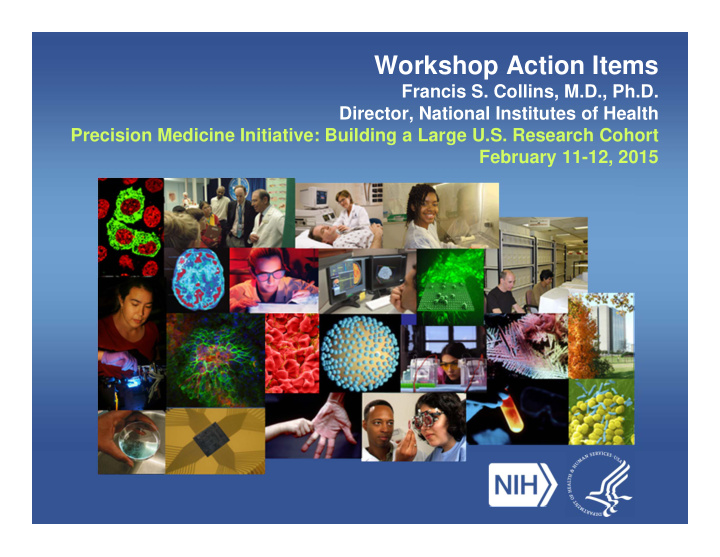



Workshop Action Items Francis S. Collins, M.D., Ph.D. Director, National Institutes of Health Precision Medicine Initiative: Building a Large U.S. Research Cohort February 11-12, 2015
Creation of a National Cohort What is the problem the cohort is trying to solve? Can we develop a set of compelling use cases?
Possible use cases (more needed) Identification and testing of biomarkers and predictive strategies for a wide range of common diseases Unbiased quantitative determination of risk (environmental exposure, genetic penetrance, GxE) Powerful test bed for mHealth applications to health maintenance and chronic disease management Opportunity for rigorous test of pharmacogenomics “The Human Knockout Project” – determining phenotype of loss of function mutations for many human genes Test bed for improving utility of EHRs for all participants Opportunity to test the ability of health care delivery systems to respond quickly to evidence – learning system
Creation of a National Cohort What is the problem the cohort is trying to solve? Can we develop a set of compelling use cases? Is there a risk of being too prescriptive and hypothesis-limited? What’s the right blend of bringing existing cohorts together, and starting new ones? What’s unique about this initiative? Why is 1 million the right number? Need more? How does the cohort support discovery and also allow testing of interventions? How critical is it that point-of-care health care delivery is included in cohort structure? How will health disparities be addressed?
Creation of a National Cohort (cont.) Are children included? Sustainability? Value grows over time. Need to learn from prior successful and unsuccessful cohort projects Need to link up with other international cohort projects Define the basic phenotype, lab, and genotype data to be sought for all participants Consider more than one tier: – Fully engaged, fully participating, with EHRs, laboratory data,.. – EHRs and permission for recontact only – “Cohort Lite”
Participants as Partners Partners aren’t just “at the table”, they’re planning the meal (and bringing the food) – avoid the patient subcommittee model! Joint membership is the goal. How do we identify those who can fairly represent the participant voice for this initiative? What research data is returned to participants? Need to define specific consequences of violation of the prohibition against re-identification – look at GA4GH ethics position Can anyone join? Or do you have to have certain characteristics (like an interoperable EHR)? Emphasize the opportunity to contribute to a larger national purpose, not just one’s own care
mHealth Technologies Need rigorous assessment of the analytical validity of health Apps that will be used for medical decisions. Then need rigorous evaluation to see if these Apps actually improve outcomes: a role for the cohort? What to do about potential barriers in such a rapidly- evolving field? – IRBs – HIPAA – Regulation of devices Privacy, security, and safety must be addressed Develop an array of incentives to encourage participants to maintain connectivity
Informatics Requirements and EHRs Need the EHR system for the cohort to facilitate discovery AND implementation Blue Button technology needs to become practical quickly Beyond provider-entered data – mHealth data from participants – Include participant-reported outcomes (like PROMIS) – “My Research Chart” Access to claims data and the death master file is crucial Centralized or federated structure? Leaning toward federated but need complete review of prior lessons Expect exponential growth in data and plan for that
Data Access and Sharing Don’t make access process unduly complex Anticipate extensive interest in depletable samples, need a system to adjudicate requests Which parts of the research effort need to be HIPAA compliant? CLIA compliant? FISMA compliant? Will cohort participants support data sharing equally with public and private sector researchers? Need to provide training opportunities for data users?
Kathy Hudson and Rick Lifton Next Steps
Next Steps Stand Up the Working Group of the ACD – Name members (February 2015) – Collect further information based on output from this meeting – Begin outlining the plan – Interim Report to the ACD in September to inform NIH decisions in FY16 Consultation and Information Collection – Cohort leaders – mHealth folks – Potential participants Governance and Coordination – Inter-agency coordination mechanism (FDA, ONC, DoD, VA, WH) – Trans-NIH implementation team a la BRAIN, BD2K
Yes, it was historic!
And the world has been watching…. Videocast: 1741 total unique views WebEx: 623 total unique views Twitter: 3813 total Tweets
We need to follow Woodrow Wilson: i.e. continue to borrow your brains…. Think further about these issues as you head homeward Send us additional thoughts: – Kathy.Hudson@nih.gov Please return our phone calls, and be prepared to drop everything if we ask you to come to another workshop
Make no little plans; they have no magic to stir men's blood and probably themselves will not be realized. Make big plans; aim high in hope and work. ~ Daniel Burnham
Recommend
More recommend